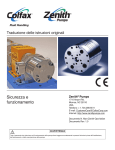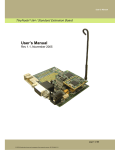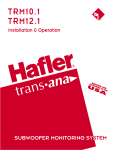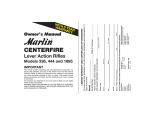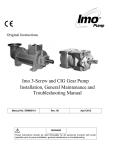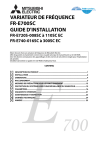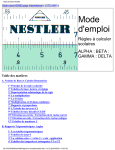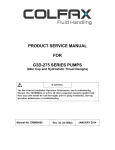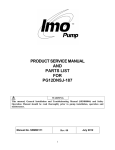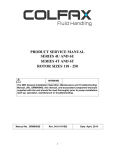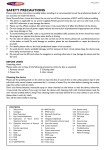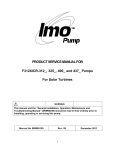Download AA2BIC SERIES PRODUCT SERVICE MANUAL
Transcript
TM AA2BIC SERIES PRODUCT SERVICE MANUAL Metric standards apply for all pumps covered by this manual with regard to mounting dimensions, external connections, bolts, bolt threads, plugs and bearings. WARNING This manual AND the following CE-compliant manuals should be read thoroughly, and in their entirety, prior to pump installation, operation and maintenance: Manual No. SRM00100 – Safety and Operation Manual. Manual No. SRM00101 – Installation, General Maintenance and Trouble Shooting Manual. Electronic copies of all referenced manuals can be obtained at www.imopump.com. Manual No. SRM00104 Rev. 00 December 2011 1 READ THIS ENTIRE PAGE BEFORE PROCEEDING FOR SAFETY OF PERSONNEL AND TO PREVENT DAMAGE TO THE EQUIPMENT, THE FOLLOWING NOMENCLATURE HAS BEEN USED IN THIS MANUAL: Warning Level Risk Level Consequences of disregarding the warning DANGER Immediate Acute Risk Death, Serious Bodily Harm WARNING Potential Acute Risk Death, Serious Bodily Harm CAUTION i NOTE Symbol Immediate Hazardous Situation Potentially Hazardous Situation Minor Bodily Harm, Material Damage Minor Bodily Harm, Material Damage Meaning Safety Warning – Take note of all information highlighted by a Safety Warning Sign and follow the instructions to avoid damage to equipment, injury to personnel or death. Electrical Hazard – Contact with electrical equipment can cause shock. Contact of electrical equipment with water can cause shock. Do NOT touch with wet hands. Always disconnect when not in use. CONTENTS Cover Sheet .......................................................................................................................................................... 1 Safety and Table of Contents................................................................................................................................ 2 General Instructions .............................................................................................................................................. 3 Introduction............................................................................................................................................................ 3 Description of Equipment ...................................................................................................................................... 4 Ordering Instructions ............................................................................................................................................. 4 Operation and Operating Limits ............................................................................................................................ 4 Spare Parts and Kits ............................................................................................................................................. 5 Inspection .............................................................................................................................................................. 5 Pump Maintenance ............................................................................................................................................... 5 Pump Disassembly ............................................................................................................................................... 6 Pump Assembly .................................................................................................................................................... 7 Installation, Alignment and Troubleshooting ......................................................................................................... 9 Field and Factory Service / Parts .......................................................................................................................... 9 Pump Assembly Drawings .................................................................................................................................. 10 IMPORTANT NOTE If operation of pump is critical to your business, we strongly recommend keeping a spare pump in stock at all times. As a minimum, a minor repair kit (O-rings, gaskets, shaft seal, bearings and retainers) should be kept in stock so pump refurbishment can be readily accomplished after inspection. 2 A. GENERAL INSTRUCTIONS Instructions found herein cover disassembly, assembly and parts identification of all size AA2BIC series Imo 3-screw pumps, that is rotor sizes -95 through -187. NOTE: Individual contracts may have specific provisions that vary from this manual. Should any questions arise which are not addressed in this manual, refer to contract and to Manual No.’s SRM00100 and SRM00101. See front cover for manual descriptions. For additional information/technical assistance please contact Technical Service Department of Imo Pump at (704) 289-6511. Every effort was made to prepare text of manual so engineering and design data is transformed into most easily understood wording. Imo Pump must assume personnel assigned to service pump have sufficient technical knowledge and are experienced to apply sound safety and operational practices which may not be otherwise covered by manual. WARNING If instructions in this manual are not correctly and strictly followed and observed, injury to personnel or serious damage to pump could result. Imo Pump cannot accept responsibility for unsatisfactory performance or damage resulting from failure to comply with instructions. B. INTRODUCTION This manual covers only series AA2BIC Imo Pumps. These pumps have been designed for general use in lubricating and seal oil applications. Size and construction of each pump is identified in model number on pump nameplate. Definitions of model designators are identified in Figure 1. Figure 1 – Model Designator Definitions 2BIC Model Nomenclature Example → Design Sequence AA 2BIC / V 143SC I 090 001 ### AA Pump Series Numerical Pump Designator 2BIC Separator / 090 V 095 / 2.0D / CW Pump Size / Lead / Rotation (1) 080 Lip Seal Material - Fluorocarbon (2) "Special" 143 / 1.5D / CW 143 / 2.0D / CW 187 / 1.15D / CW 187 / 1.45D / CW 187 / 1.75D / CW Motor Frame Size 100 095SC 143SJ 143SC 187AY 187SY 187SM I IEC Motor Standard NOTE - The letter X in any nomenclature position indicates a non-standard pump model. If an X is present, a 3-digit suffix number should also be present. (1) No number will be present unless pump is a special (non-standard) model. (2) Rotation is based on facing end of drive shaft. 3 C. DESCRIPTION OF EQUIPMENT AA2BIC Series pumps are positive displacement, rotary screw pumps consisting of a precision bored housing that encloses a drive screw (power rotor) and two intermeshing driven screws (idler rotors). These screws, when rotating, form a succession of closures or cavities. As they rotate, fluid is moved axially from inlet to outlet port in a continuous, uniform flow with minimum fluid pulsation and pump noise. NOTE: AA2BIC Series pumps are NOT bi-rotational; Inlet and outlet ports can NOT be reversed. D. ORDERING INSTRUCTIONS All correspondence pertaining to replacement parts for equipment must refer to instruction manual number and should be addressed to nearest Imo representative. Handling of replacement part orders will be greatly facilitated if directions below are carefully observed: 1. Provide number of instruction manual with revision level and date. 2. Provide model number of the pump for which part is desired. Number appears on nameplate. 3. Designate desired part by Position No. and name as shown on assembly drawing and as listed in Table 2 below. E. OPERATION E.1 – LIQUID LIMITATIONS CAUTION Pump is designed for liquids having general characteristics of oil including requirement for at least some lubricity. Since pump ball bearing is lubricated by pumped liquid due to open ball bearing design, never operate 2BIC Series pumps with a liquid having a viscosity less than 2.0 cSt (33 SSU). Never operate pump on water. E.2 – OPERATING LIMITS CAUTION Operating conditions, such as speed, fluid viscosity, temperature inlet pressure, discharge pressure, filtration, duty cycle, drive type, mounting, etc., are interrelated. Due to these variable conditions, specific application limits may be different from that of operational limitations. Equipment must not be operated without verifying that system’s operating requirements are within pump’s capabilities. Table 1 – Pump Operating and Structural Limits Maximum Speed ......................................................................................................................................... 3600 RPM Viscosity ..............................................650 cSt (3,000 SSU) maximum / 2.0 cSt (32.6 SSU) minimum for all models NOTE: Do not alter design viscosity without prior consultation with Imo Pump. Consult factory for allowable operating viscosities at specific speeds and pressures. Temperature....................................................................................................................... -18° to 82°C / 0° to 180°F Inlet Pressure – Maximum ............................................................................................................ 1.7 bar-g / 25 psig Differential Pressure – Maximum ................................................................................................... 11.7 bar / 170 psi Discharge Pressure – Maximum .................................................................................................. 11 bar-g / 160 psig Drive .......................................................................................................................................................... Direct only Filtration ............................................................................. See Manual No. SRM00101 (description on front cover) Mounting ........................................................................................................................................... Flange mounted Shaft Rotation ......................................................................................................... Clockwise facing the pump shaft NOTE: Pump is not bi-rotational 4 F. PARTS LIST Part number identifiers (POSITION NUMBERS / POS. NO.’s) contained in Table 2 refer to circled numbers shown on assembly drawings, Figures 2 and 3. Table 2 – Parts List POS. NO. 1 QTY DESCRIPTION POS. NO. 11 QTY 1X DESCRIPTION 1 Housing Ball Bearing 2 1 Inlet Cover 15 X 2 (*1) 3 2 Bolt 16 X 1 Seal Retaining Ring 4 1 Inboard Cover 21 2 Bolts for Foot Bracket 6 4 Bolt 31 X 1 O-Ring 7 1 Power Rotor 32 X 1 Gasket (143 and 187 rotor sizes) 8 2 Idler Rotor 33 2 Bolt 34 X 1 O-Ring (95 rotor size only) X = Minor Repair Kit Item *QTY=1 for 187 rotor sizes G. INSPECTION Interval for inspection and replacement of worn parts varies with properties of pumped liquid and can only be determined by experience. A worn pump will be noticeable by excessive vibration, noise, reduction in flow output and/or reduction in system pressure. CAUTION All AA2BIC series internal pump parts, including ball bearing, are lubricated by pumped liquid. Pumping a liquid which contains abrasive materials, that is too low in viscosity or lubricity, or that is corrosive, will significantly reduce service life and call for shorter service intervals. H. PUMP MAINTENANCE WARNING Failure to observe precautions while installing, inspecting, and maintaining the pump can cause injury to personnel from accidental handling, e.g.: Liquids that may harm skin or clothing, fire hazard risks from flammable liquids, or injury from high pressure fluid jets. DANGER BEFORE working on equipment, be sure all power to the equipment is disconnected and locked-out. 5 H.1 – GENERAL COMMENTS Part number identifiers (POSITION NUMBERS / POS. NO.’s) within parenthesis such as (8) refer to circled numbers shown on assembly drawings, Figures 4 and 5. NOTE: If upon disassembly, significant wear on power or idler rotors or rotor housing is found, Imo Pump recommends replacement of entire pump. H.2 – TOOLS REQUIRED Procedures described in this manual require common mechanics hand tools, arbor press, torque wrench and suitable lifting device such as sling for smaller pumps or strap for larger models. H.3 – PUMP DISASSEMBLY WARNING Fluid leakage may make floor slippery and cause personal injury when pump is removed from system or when it is disassembled. Perform the following steps before disassembling pump: a) If pump is driven by an electric motor, de-energize and lock out power to driver and tag power control box “WARNING - Out of Service”. Proceed similarly for other type drivers. b) Close all inlet and outlet valves and tag valves “WARNING - Out of Service”. c) Vent pressure in pump and drain pumped liquid. d) Remove pipe fittings/flanges at pump inlet and outlet openings. e) Remove bolts holding pump to motor. f) Withdraw pump from motor shaft and place it on a suitable workbench. NOTE: AA2BIC Series pumps incorporate highly finished precision parts that must be handled carefully to avoid damaging critical machined surfaces. Removed parts should be tagged for identification and their exact positions in pump should be noted so new and removed parts can be properly replaced. CAUTION When removing inboard cover (4) from pump, DO NOT pull out power rotor (7) and idler rotors (8) at same time since they may drop out and be damaged. If rotors start to come out, hold them in place. 1. Remove inboard cover (4) from pump housing (1) after first removing bolts (6) from cover (4). You may need to gently tap the cover (4) from side to side to release it from the ball bearing (11). Gently slide the cover (4) along with lip seal (16) off over the hollow end of the power rotor (7) 2. Remove O-ring (31) from the counter bore in the housing (1). IMPORTANT NOTE In the next step, the lip seal will be permanently damaged upon removal. It should only be removed from the cover plate when a new lip seal is being installed to replace a worn lip seal. Care must be taken to avoid damage to the soft aluminum. 3. Lip Seal Removal. a. Support the inboard cover (4) beneath its small end using wooden blocks so that the nose and o-ring (31) sealing surfaces are elevated for protection. b. Evenly press the old lip seal (16) out of the cover (4) using an arbor press and a drift sized such that it will apply pressure to the seal’s metal insert without contacting the aluminum housing. NOTE: • If only replacing seal, proceed to steps 8 through 10, and finally step 13 in PUMP ASSEMBLY / REASSEMBLY section below to install new seal and complete pump reassembly. 6 • If the remainder of pump needs to be disassembled, proceed with Step 4 immediately below. CAUTION In next step, rotors will be removed from pump. They will come out as a unit. Use care to support rotor set as it is withdrawn from housing so idlers will not be dropped on floor. 4. Remove rotor set, power rotor (7) and two idler rotors (8), from pump by grasping and gently pulling on drive shaft end of power rotor (7). When ends of idler rotors (8) clear discharge end of housing (1), hold all 3 rotors together and ease out as an assembly. Once rotor assembly is removed, disengage both idler rotors (8) and set aside. CAUTION Only remove the ball bearing if it must be replaced with a new bearing. Removal increases the risk of damaging the shaft seal surfaces. Removal of bearing by force applied to its outer ring could damage bearing. 5. Remove ball bearing (11) from power rotor (7) by first removing the outer retaining ring (15) from groove in power rotor (7) shaft. The inner retaining ring (15) should be removed towards and over the outer diameter of the rotor screw thread. Ball bearing (11) can then be removed with a gear puller or arbor press. 6. Remove inlet head (2) after first removing four bolts (3 and 33) from inlet head (2). 7. Remove O-ring (34), or gasket (32) depending on pump size, from inlet head (2). H.4 – PUMP ASSEMBLY / REASSEMBLY NOTE: Prior to pump assembly, all parts should be cleaned and inspected for nicks, burrs or gouges. When ready for assembly, wipe all parts, including bolts, O-rings and seal faces with a clean, lubricating oil or pumped product, if applicable. 1. Install a retaining ring (15) into the groove nearest the middle of the pump shaft (7). The -187 pump has a fixed shoulder instead of an inboard retaining ring. The retaining ring (15) should be installed from the screw thread end of the -095 and -143 pumps. Do not scratch the bearing or lip seal surfaces. CAUTION The sealing surface of the shaft must not be scratched during installation of the retaining rings or bearing - leaks will result. 2. Lubricate the shaft with oil. The ball bearing (11) may be preheated to 70 °C / 160 °F to reduce the force required for installation. Install ball bearing (11) onto power rotor (7) using an arbor press and sleeve by pushing on ball bearing (11) inner ring only until ball bearing (11) is positioned against the inner retaining ring (15). CAUTION Bearing service life could be significantly reduced if pushed onto shaft by outer ring. 3. Install retaining ring (15) in groove of power rotor (7) outboard of the bearing. 4. Mesh two idler rotors (8) and power rotor (7) together into a rotor assembly making sure ends of idler rotors are properly engaged into slots in power rotor. 5. Install rotors by positioning pump housing in a vertical position and sliding rotor assembly into housing bore (1) until ball bearing (11) bottoms out in housing bore. 6. Lubricate and install O-ring (31) in counter bore of housing (1). 7. Before installing seal (16), insure power rotor (7) shaft is clean and has no burrs or sharp edges. 7 IMPORTANT NOTE If the lip seal (16) is already fit into the inboard cover (4) then proceed directly to step 9. CAUTION Do not press on the lip or energizing spring of the seal during installation. Make sure that that the installation tool does not damage bores in the soft aluminum. 8. Lip Seal Installation. a. Clean the seal bore of the cover (4) and lip seal (16) diameter. Verify that there are no scratches or any debris present in the seal bore. b. Apply light film of clean lubricating oil to the lip seal OD. c. Place the motor side of the cover (4) down and support it by the boss underneath the seal bore. Align the seal (16) with the bore and orient it as shown in figures 2 or 3. d. Use an arbor press and a plastic cylindrical tool to apply force evenly over the wetted end of the lip seal (16) without scratching the cover plate (4). Do not press on the lip or on the energizing spring of the lip seal (16). Insert the seal until it contacts the bottom of the seal bore. 9. Install inboard cover (4) on housing (1). CAUTION The inboard cover (4) drain hole should be facing down when the pump is in a horizontal orientation. This drain hole is used to detect leakage past the lip seal before it can accumulates to a significant volume. 10. Install four bolts (6) into inboard cover (4) and thread bolts into housing (1). Torque bolts to value shown on assembly drawing (Figures 4, 5 or 6). 11. Install O-ring (31) in groove in inlet head (2) for size 095 pumps. Place gasket (32) onto inlet side of housing (1) for 143 and 187 sized pumps. 12. Install inlet head (2) onto housing (1) with cap screws (3 and 33). 13. Apply a thin coat of molybdenum based grease to the bore of the shaft (7) to prevent corrosion between the motor shafts and pump shaft (7). 8 I. INSTALLATION, ALIGNMENT AND TROUBLESHOOTING Install coupling to pump drive shaft. Align pump and driver shafts per Manual SRM00101. Whenever possible, prime the inlet cover and pump discharge port with oil for start up lubrication. Connect piping to pump. Open inlet and outlet line valves. DANGER 3-screw pumps are positive displacement types. They must NOT be started with blocked outlet lines. For detailed instructions regarding installation, alignment, operation general maintenance and trouble shooting, see Manuals SRM00101. J. FIELD AND FACTORY SERVICE / PARTS Imo Pump maintains a staff of trained service personnel that can provide pump installation, pump start-up, maintenance/overhaul and troubleshooting supervision as well as installation and maintenance training. Our factories have facilities and personnel to inspect, maintain, overhaul and test pumps in the event user prefers to return pumps for these services. Pumps that have been factory-overhauled are normally tested and warranted “asnew” for a period of one year from date of shipment. For either field service or factory overhaul assistance, contact your local Imo Sales Office or representative at the Technical/Customer Service Department in Monroe, NC, USA, (704) 289-6511. Minor Repair Kits are available for AA2BIC series pump models. Minor Repair Kits are used to repair leaking seals, rough or failed bearings and/or for re-assembly after pump tear-down. They include (as applicable) lip seals, O-rings, bearings and any part that might be damaged during disassembly (e.g., retainer rings). Kits contain all necessary parts. Individual parts within Minor Repair Kits are not sold. If major pump components (e.g., rotors or housings) are heavily worn or damaged, entire pump should be replaced. 9 K. PUMP ASSEMBLY DRAWINGS Figure 2 AA2BIC-095 Rotor Size 34 7 4 31 8 TORQUETO 20.3 ± 1N•m [ 180 ± 10 LB-IN] 6 8 15 SECTIONB-B TORQUE TO8.1± .5 N•m [ 72 ± 5 LB-IN] 3 2 11 1 16 INLET OUTLET B B 33 SECTIONA-A TORQUE TO8.1± .5 N•m [ 72 ± 5 LB-IN] 10 Figure 3 AA2BIC-143 and 187 Rotor Sizes 7 32 SECTIONB-B 8 8 1 2 4 15 31 11 16 INLET TORQUETO 33 ± 3 N•m [ 24 ± 2 LB-FT ] TORQUE TO 33 ± 3 N•m [ 24 ± 2 LB-FT ] OUTLET 6 3 B B TORQUETO 33 ± 3 N•m [ 24 ± 2 LB-FT ] 1/8-28 BSPT DRAIN 33 SECTIONA-A 11 COLFAX CORPORATION Imo Pump 1710 Airport Road Monroe, NC USA 28110 tel 704.289.6511 email [email protected] web www.Imopump.com COLFAX, ALLWEILER, BARIC, COLFAX BUSINESS SYSTEM, FAIRMOUNT AUTOMATION, HOUTTUIN, Imo, LSC, ROSSCOR, TUSHACO, WARREN and ZENITH are registered trademarks of the Colfax Corporation or its subsidiaries in the U.S. and/or other countries. 12












